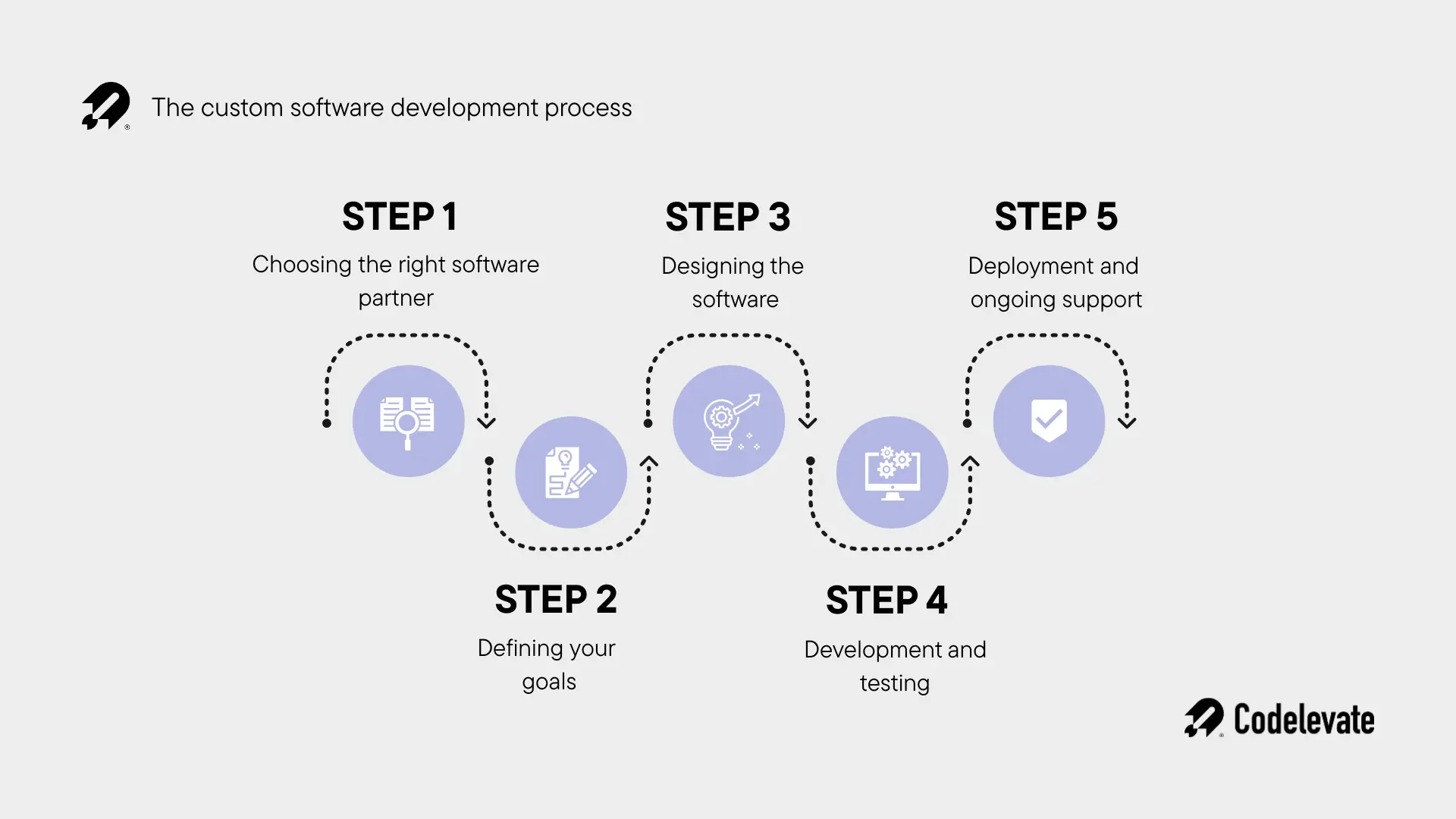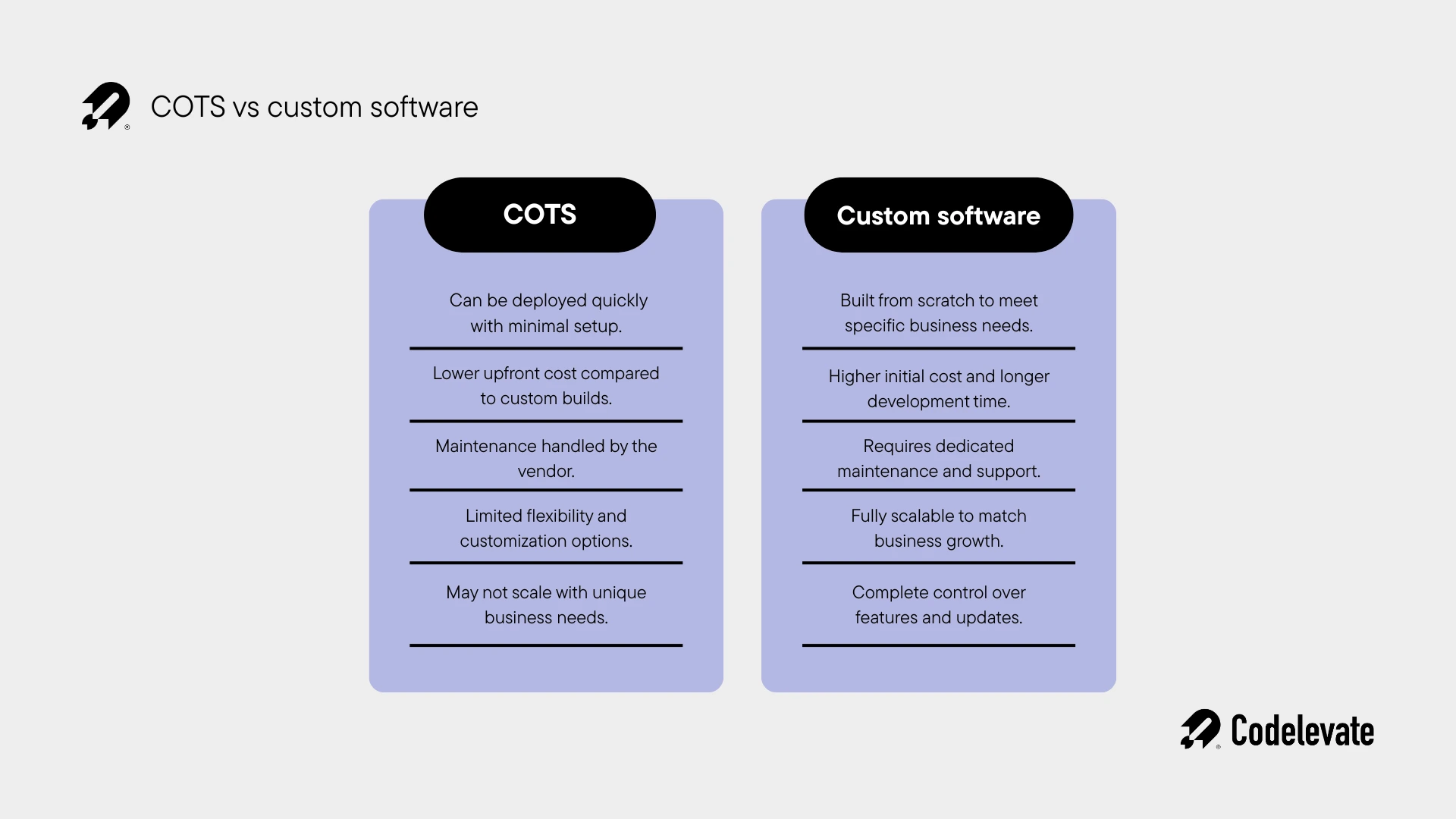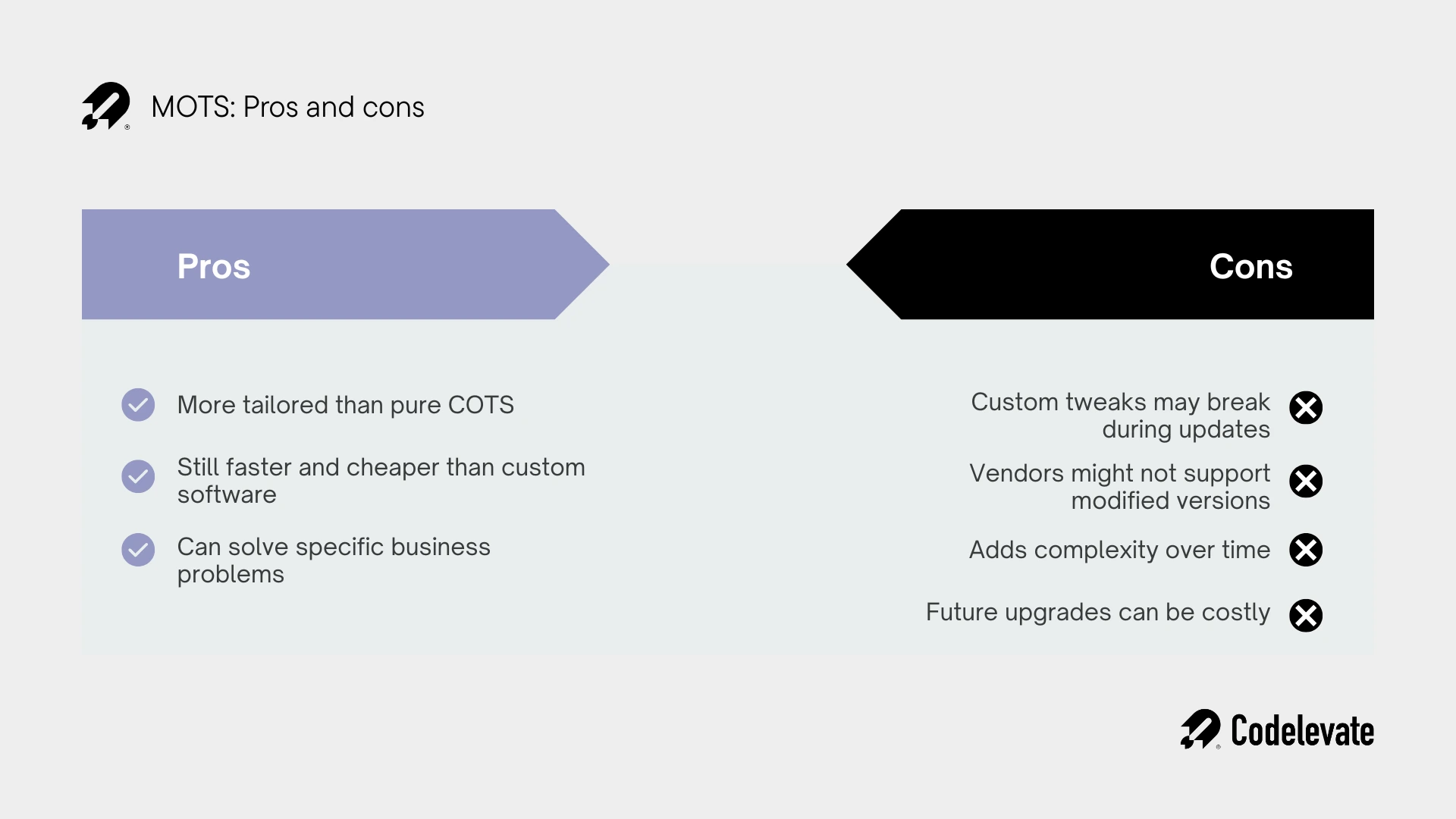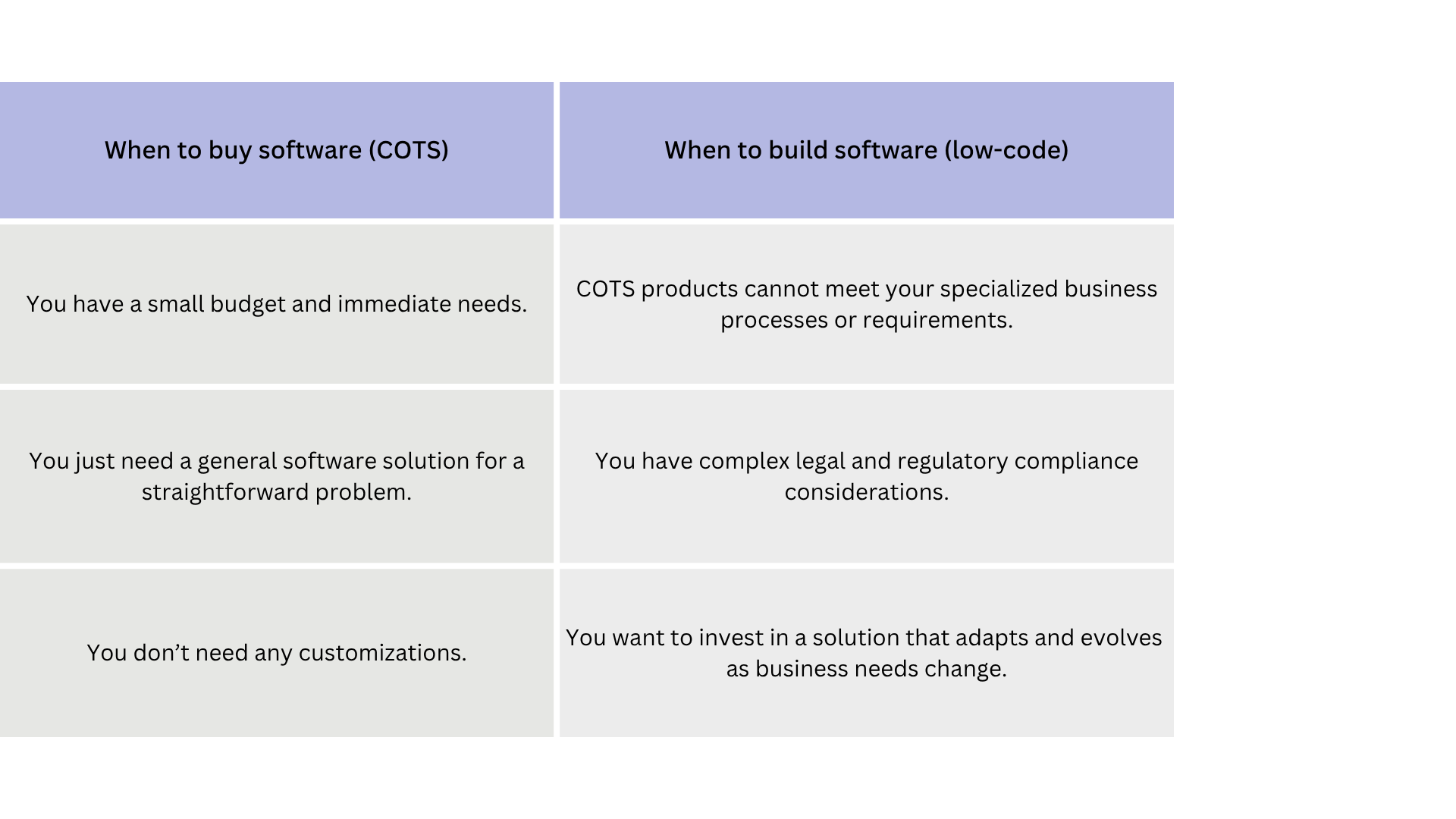Off-the-shelf (COTS) vs. custom software: Pros, cons, and examples
Software is the heartbeat of modern business, but building custom solutions from scratch is time-consuming, expensive, and risky. That’s where commercial off-the-shelf (COTS) software steps in. If you’ve ever used ready-made software like QuickBooks, Microsoft Office, or Salesforce, you’ve experienced COTS in action. These tools are built for mass use and are ready to go—right out of the box.
Whether you’re a small startup trying to save time and money or a large enterprise seeking reliable tools to manage operations, COTS software can be a game-changer. But it’s not a one-size-fits-all solution. In this blog, we’ll walk you through everything you need to know about COTS—what it is, why it matters, when it works best, and when it might fall short.
Let’s dive in!
.webp)
What is commercial off-the-shelf (COTS) software?
Commercial Off-the-Shelf (COTS) software is software that’s pre-built and sold to the general public or businesses in a ready-to-use format. It’s like buying furniture from IKEA rather than hiring a carpenter to build a custom table. You get a functional product that solves a general need, without the long wait or high price tag. COTS software is created by vendors with the intention of being used by a wide range of organizations across industries. It’s already tested, supported, and often updated regularly. Think of software like SAP, Zoom, or Dropbox. These tools serve thousands (if not millions) of users, and they’re designed to solve common problems—such as document editing, enterprise planning, or communication—without needing to build something from scratch.
Examples of COTS software
You’ve probably used off-the-shelf software more times than you realize. These are pre-built solutions that are ready to go as soon as you install them—no customization needed. They’re commonly used across all industries for handling day-to-day business needs. Here are three of the most widely used off-the-shelf software tools that businesses around the world rely on:
1. Microsoft Office Suite
A household name, the Microsoft Office Suite includes familiar apps like Word for writing documents, Excel for managing spreadsheets, PowerPoint for creating presentations, and Outlook for handling email. These tools help teams stay productive and organized without the need for custom development.
2. Salesforce
Salesforce is a leading customer relationship management (CRM) platform. It comes packed with tools for sales, customer service, marketing, analytics, and app development. It’s built to help companies of all sizes streamline their customer interactions and close deals faster.
3. QuickBooks
Designed for small to mid-sized businesses, QuickBooks is a user-friendly accounting software that helps manage invoices, expenses, payroll, and detailed financial reports. It’s a great fit for companies that want to automate their financial processes without hiring a full accounting team.
Advantages of COTS software
Let’s face it—businesses don’t always have the luxury of time or money. That’s one reason why many turn to COTS. But the benefits go beyond just cost.
1. Cost savings
COTS spreads its development cost across many customers. This lowers the price for each user. Instead of investing thousands—or millions—into a custom tool, you get access to powerful software for a fraction of the cost.
2. Speed to market
COTS tools are ready now. No waiting for months of development or rounds of revisions. You can install it today and start using it tomorrow.
3. Proven reliability
These tools are battle-tested. Thousands of users have already helped iron out bugs and refine performance. This leads to better stability and less downtime for your team.
4. Regular updates and support
Most COTS vendors offer consistent updates, patches, and technical support. That means your software improves over time without you lifting a finger.
5. Lower risk
Custom software can fail—it might be late, over budget, or not what you expected. COTS reduces those risks by offering a well-known, stable alternative.
Disadvantages of COTS software
Of course, no solution is perfect. COTS software has its drawbacks, and ignoring them can cost you in the long run.
1. Limited customization
Because COTS is made for the masses, it might not do exactly what you need. You may have to change your processes to fit the software—not the other way around.
2. Integration hurdles
COTS tools aren’t always a natural fit with your existing tech stack. You might need extra tools or IT support to get everything working smoothly.
3. Vendor lock-In
When you choose a COTS product, you’re tied to the vendor’s updates, pricing, and roadmap. If the vendor goes out of business or changes direction, you might be left scrambling.
4. Security risks
Popular software is a bigger target for hackers. While vendors do their best to patch holes quickly, relying on a widely used tool can increase your exposure to cyber threats. Consider using services like Have I Been Pwned to stay informed about data breaches.
5. Regulatory compliance issues
Industries like healthcare or finance have strict regulations. COTS tools may not come ready for those needs, which can lead to compliance headaches. Tools like OneTrust help businesses manage compliance with frameworks such as GDPR or HIPAA.
Real-life applications of COTS software
COTS software is everywhere. No matter your industry, chances are there’s a COTS product that meets at least 80% of your needs. Here’s how it plays out in real-world businesses:
1. ERP systems (Enterprise resource planning)
Tools like Oracle NetSuite help companies manage finance, HR, supply chains, and operations all in one place.
2. CRM software (Customer relationship management)
HubSpot, Zoho CRM, and Salesforce let teams track leads, manage contacts, and improve customer service.
3. Project management tools
Think Asana, Trello, or Monday.com. These tools help teams plan, execute, and track tasks across departments.
4. Accounting software
QuickBooks or FreshBooks streamline bookkeeping, invoicing, payroll, and tax reporting.
5. Communication platforms
Zoom, Slack, and Microsoft Teams help remote and hybrid teams stay connected.
6. Security and compliance tools
Antivirus software, Malwarebytes, data encryption platforms, and compliance tools protect sensitive data.
How to validate COTS software before you buy
Just because a tool is popular doesn’t mean it’s right for you. Validation is key.
- Test functionality
- Check whether the software does what you need. Ask for a demo or trial version and get hands-on with your use cases.
- Evaluate security
- Ask about encryption, authentication, and how the software protects user data.
- Measure performance
- Will it handle your expected volume? Can it scale with your growth?
- Assess integration
- See how easily it fits into your current setup. Look at APIs, data formats, and compatibility.
- Get user feedback
- Let your team test the software and give feedback. If they don’t like it, they won’t use it.
Choosing the right vendor and integrating the software
COTS software isn’t plug-and-play magic—it still takes careful planning.
Vendor checklist:
- Do they have a strong track record?
- Are they financially stable?
- Do they offer training and support?
- What’s their product roadmap?
- Can they grow with you?
Integration tips:
- Start with a clear needs assessment
- Prioritize compatibility with existing systems
- Prepare for data migration early
- Limit customizations to reduce long-term headaches
- Train your users before the go-live date
- Use a phased rollout for complex systems
Integration takes time, but with a thoughtful plan, your transition can be smooth and successful.
What is custom software?
While many companies rely on ready-made tools, there’s another powerful option on the other side of the tech spectrum: custom software. Also known as bespoke software or tailor-made software, custom software is created specifically for one business or organization. Unlike off-the-shelf software that serves a broad audience, custom solutions are designed to match your exact processes, preferences, and system requirements. Custom software development allows you to build a tool that fits your business like a glove. It’s flexible, scalable, and grows alongside your organization—something generic apps just can’t offer. Whether you’re building a secure internal platform or an advanced enterprise application, going custom means you control every detail—from design to deployment.
The custom software development process

If you’re comparing custom software vs off-the-shelf solutions, it’s helpful to understand how the custom software development process works. Here’s a simplified breakdown of the main stages:
1. Choosing the right software partner
Every great custom project begins with selecting the right development partner. This isn’t just about finding a team that codes—it’s about choosing a company that understands your business goals, industry, and vision.
Start by reviewing their portfolio, reading client testimonials, and understanding their development capabilities. Platforms like Clutch or GoodFirms can help you compare vendors based on reviews and case studies.
Once you’ve found the right fit, the next step is to sign a software development agreement. This document outlines responsibilities, timelines, costs, and expectations—setting the tone for a smooth collaboration.
2. Defining your goals
Before writing a single line of code, it’s important to clearly define what you want to achieve. The development team will work closely with you to explore:
- Business goals
- Key features and functionality
- Preferred user experience
- Desired project outcomes
Together, you’ll map out a plan that includes the project’s scope, timeline, and the right technology stack (such as Python, Java, or .NET). This foundation ensures that your software aligns perfectly with your company’s strategy.
3. Designing the software
Next, the process moves into the design and planning phase. This is where the user experience (UX) and interface (UI) come to life.
The team will:
- Create wireframes and visual designs
- Plan user journeys
- Ensure the layout is intuitive and user-friendly
- Customize features to match your daily operations
This step focuses on both how the software looks and how it functions. Collaboration and feedback are essential here, and tools like Figma or Adobe XD are often used for interactive prototyping.
4. Development and testing
With the design locked in, it’s time to start building your software. During this development phase, programmers use clean, scalable code to bring your features to life.
To ensure the software performs well, it goes through rigorous testing. This includes:
- Unit testing
- Integration testing
- Security testing
- User acceptance testing (UAT)
Using platforms like Jenkins or Selenium, teams catch and fix bugs early. This step is key to delivering high-quality, reliable software that won’t crash or slow down during real use.
5. Deployment and ongoing support
Finally, it’s time to launch your custom software and integrate it into your business environment.
This stage involves:
- Deployment to cloud platforms like AWS or Microsoft Azure
- Creating detailed documentation and user manuals
- Offering training for your team
- Providing long-term support and updates
The development team stays involved to maintain performance, fix issues, and roll out new features as your needs evolve.
Ongoing support helps you stay ahead of changes in your industry and ensures that your investment continues to deliver results.
Advantages of custom software
In today’s fast-moving digital world, more businesses are turning to custom software solutions to meet their unique needs and gain a competitive edge. While off-the-shelf software might be quick to deploy, it often comes with limitations. Custom software, on the other hand, is built from the ground up to match your exact business operations and goals. Let’s explore the top benefits of investing in a tailored software solution.
1. Tailored to fit Your business
Custom software is designed specifically around your company’s processes, not the other way around. Every feature, layout, and function supports your unique workflows, user roles, and business logic. This personalized approach allows your team to work more efficiently and avoids the need to adapt to the limitations of pre-built systems like Trello or Asana, which are often built for general audiences.
2. Flexibility to evolve
As your business grows, your needs change — and your software should grow with you. Custom software is easy to scale and adapt. Whether you’re adding new features, integrating new tools, or expanding operations, your solution can evolve seamlessly. Tools like Docker and Kubernetes help modern developers build scalable software that keeps pace with innovation.
3. Competitive advantage
One of the biggest benefits of custom enterprise software is the strategic edge it offers. Your solution is one-of-a-kind, tailored to your processes and goals. It can do things your competitors’ tools can’t, boosting performance, innovation, and operational efficiency. You’re not just buying software — you’re building a system that sets you apart.
4. Full ownership and control
With custom software, you own the code. This means full control over how your software is used, changed, or expanded — without being limited by vendor pricing models or license terms. You also avoid vendor lock-in, a common issue with platforms like Salesforce or HubSpot, where switching providers can be expensive and difficult.
5. Long-term cost efficiency
While the upfront cost of custom software can be higher, it’s a long-term investment. You eliminate monthly subscription fees, per-user charges, and the need for costly workarounds. As your team becomes more productive and your workflows are streamlined, the cost savings will add up — often outweighing initial development expenses.
6. Personalized support and maintenance
When you build custom software, your development partner gets to know your business inside and out. This means faster, more relevant support when issues arise or when updates are needed. Compared to generic platforms with standard support, custom teams can troubleshoot, advise, and improve your software much more effectively.
7. Easy integration with existing tools
Custom software can be built to integrate with the tools you already use — like Slack, Stripe, or Google Workspace. This saves your team from switching between systems and keeps all your data connected and accurate. By avoiding manual data entry and tool mismatches, you save time and reduce costly errors.
8. Automating and streamlining operations
One of the key benefits of custom development is business process automation. Whether you’re automating customer onboarding, internal reporting, or sales workflows, your software can simplify day-to-day tasks and free your team to focus on strategic work. Many companies use integrations via Zapier or custom APIs to connect their systems and automate repetitive jobs.
9. Centralized data management
Forget juggling multiple Excel spreadsheets and outdated tools. Custom software helps consolidate your data in one secure system. That means everyone accesses the same version of the truth — in real-time. It’s a game-changer for growing teams that need reliable insights and collaboration.
10. Better business intelligence
Custom dashboards and analytics tools give you real-time insights into business performance. Your software can track KPIs, sales trends, customer behavior, and more — tailored to what matters most to you. With built-in reporting tools and data visualization platforms like Power BI or Looker, your software becomes a decision-making powerhouse.
11. High performance and eco-friendly development
Custom software is designed for speed and efficiency. Built using lightweight, modern programming languages like Rust or Go, it can perform better than bulkier pre-made platforms. Plus, more developers are focusing on green coding practices, creating solutions that are not only fast but also eco-friendly — making it easier for companies to support sustainability goals.
Disadvantages of custom software
While the benefits are significant, it’s also important to weigh the potential drawbacks of building custom software.
1. Higher upfront costs
Developing a solution from scratch involves a bigger initial investment. It requires time, skilled developers, and clear planning — which may not suit startups or small businesses with limited budgets. However, platforms like Openkoda help reduce these costs with reusable modules and AI-assisted development.
2. Longer development timelines
Unlike plug-and-play tools, custom software takes time to build. Depending on complexity, it can take weeks or even months to launch. If you need something immediately, consider using a low-code platform as a stepping stone while your custom app is in progress.
3. Developer dependency
Relying on a specific developer or agency for updates and support can be risky if they become unavailable. To avoid this, always ensure you own your source code, have proper documentation, and use widely adopted frameworks.
4. Risk of over-complexity
With full customization power comes the risk of making your software overly complex. Without clear planning, you could end up with a system that’s hard to use or train employees on. The key is to focus on usability and prioritize features that directly impact business results.
5. Project risk
Like any major project, custom software carries risks. If it’s not well managed, it can run over budget, miss deadlines, or fail to meet expectations. Using agile project management methods and tools like Jira can help keep development on track and transparent.
Real-world examples of custom software
Finance: A secure, high-performance custom financial platform was created to handle complex transactions and massive data volumes — giving the client a unique edge in speed and security.
Accounting: A tailor-made accounting system helped streamline specialized workflows, reduce manual errors, and cut long-term costs by automating time-consuming processes.
Travel: A scalable travel search engine capable of managing real-time hotel and flight data (handling over 300 million queries daily) ensured that users always received accurate, up-to-date information — something off-the-shelf tools couldn’t guarantee.
Ecommerce: A real-time pricing engine connected to external pricing sources allowed an ecommerce company to sync pricing across its website, mobile app, and physical stores. This created a seamless, consistent shopping experience for customers.
Openkoda: the hybrid approach that changes the game
If you want the benefits of both off-the-shelf and custom software, Openkoda offers a smart solution. It’s a next-gen development platform that uses out-of-the-box modules for rapid setup but still allows full customization through clean Java code. With an AI assistant built in, Openkoda helps developers build faster, smarter, and with fewer bottlenecks. Best of all, you maintain full control — no vendor lock-in, no forced cloud hosting. Whether you’re in insurance, logistics, legal tech, or beyond, Openkoda is flexible enough to meet your needs and powerful enough to future-proof your growth.
COTS vs. custom software: which is better?
Let’s compare the two head-to-head:
COTS software:
- Faster to deploy
- Lower upfront cost
- Easier to maintain (vendor handles it)
- Less flexibility and customization
- May not scale with unique business needs
Custom software:
- Designed exactly for your needs
- Higher initial cost and longer to build
- Requires more ongoing maintenance
- Fully scalable to fit your growth
In short: COTS is faster and cheaper, but custom software gives you full control. The right choice depends on your goals, budget, and timeline.

The middle ground: modified off-the-shelf (MOTS)
Sometimes, businesses try to split the difference with Modified Off-the-Shelf software (MOTS). This means starting with a standard COTS product and adding a few tweaks or customizations to make it a better fit.
It sounds perfect, right? A little custom, a little off-the-shelf.
Pros of MOTS:
- More tailored than pure COTS
- Still faster and cheaper than custom software
- Can solve specific business problems
Cons of MOTS:
- Custom tweaks may break during updates
- Vendors might not support modified versions
- Future upgrades can be costly
- Adds complexity over time
If you’re considering MOTS, make sure your vendor is onboard and your IT team is ready to support the hybrid setup.

When should you buy (COTS) vs. build (custom)?
Here’s the truth: no software fits every business perfectly. Even the best COTS product will have missing features or unnecessary tools you’ll never use. And as your company grows, that once-perfect tool might start to feel limiting. You might expand into new markets, add new teams, or adopt new regulations. Can your current COTS software keep up? If not, you’ll face growing pains—extra costs, workarounds, and maybe even switching tools entirely. That’s why businesses often evolve their strategy. Some start with COTS, then layer in MOTS tweaks, or eventually shift to a custom-built solution when they can afford it. Low-code development platforms are also changing the game. These platforms let businesses build custom apps quickly, without needing to hire a full team of developers. They’re visual, flexible, and much cheaper than traditional custom builds. Tools like OutSystems, Mendix, and Microsoft Power Apps make it easier than ever to strike the right balance between speed, cost, and customization.

Conclusion
Commercial off-the-shelf (COTS) software offers a convenient, affordable solution for many business challenges. It’s proven, supported, and ready to use. But like any tool, it has its limits. The best approach? Start by understanding your business needs—deeply. Know what’s essential and what’s just nice to have. Look at your current systems, your team’s workflow, and your long-term goals. COTS might be the right fit today, but it doesn’t have to be your forever solution. As your business grows, so too should your tools. Whether that means upgrading to MOTS, shifting to custom development, or exploring low-code platforms, the key is staying flexible. There’s no one-size-fits-all answer—but with the right strategy, you’ll find the best fit for your organization.
Do you need help selecting the right software development partner? Reach out to our experts for a personalized consultation today. Happy building!




.webp)
.svg)




